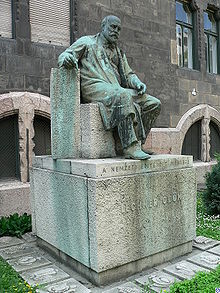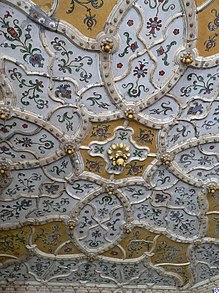Ödön Lechner
Ödön Lechner (born August 27, 1845 in Buda , Austrian Empire ; † June 10, 1914 in Budapest , Austria-Hungary ) was a Hungarian architect who achieved great fame due to his buildings influenced by Art Nouveau .
Life
The origin of the family is assumed based on the name in Bavaria , the family immigrated to Budapest via Burgenland in the 18th century . His father ran a brick factory. He studied architecture in Berlin.
From 1875 to 1878 he got to know the formal language of Art Nouveau in Paris. Together with his friend Vilmos Zsolnay , whose family ran a manufacture for building ceramics, he was the inventor of the material known as “pyrogranite”, a green-gray granite - like artificial stone that Lechner liked to use in his buildings. Numerous elements from this manufacture were used in his buildings. Gyula Pártos was often involved in the designs for his buildings.
Several large buildings were built in the last decade of the 19th century, when Hungary began to reflect on its national feeling and many buildings were built in Budapest. Already with the construction of the town hall in Szeged he found great recognition and set standards in Budapest with the construction of the arts and crafts museum, which is dominated by floral elements. The interior was whitewashed in 1920 so as not to distract from the exhibits. Another large building was built with the building for the university's geological institute, now the geological museum. With the Post Office Savings Bank, which is now part of the National Bank building, another Art Nouveau showpiece was created in Budapest. Here he implemented the idea of his own Hungarian national style. He was in contrast to Otto Wagner , who also built a building for the Post Office Savings Bank in Vienna, but held the view that modern buildings in large cities should be designed independently of national considerations.
Lechner used decorative elements from Hungarian folk art in his buildings, the sources of which are believed to have been in Persia or India during the time of Hungarian nationalism.
In the reception of his works he is seen as an early representative of the Secession in Hungary , some compare his work with that of Antoni Gaudí . The Hungarian organic architecture, which has emerged from around 1975 with its main representatives Imre Makovecz and György Csete, can be seen as a partial continuation of certain traditions shaped by Lechner in its emphasis on the folk-artistic and national element.
Ödön Lechner was buried in the Kerepesi cemetery in Budapest (field 28).
buildings
- Town Hall (Szeged) (1882)
- Town Hall (Kecskemét) (1892-1894)
- Decorative Arts Museum , Budapest (1893–1896) together with Gyula Pártos
- Ladislaus Church, Budapest (1894-1896)
- Geological Museum, Budapest (1896–1899)
- Postal Savings Bank in Budapest (1899–1902), today part of the National Bank and cannot be visited .
- "Blue" Elisabeth Church in Pressburg (1907-13)
- St. Ladislaus High School in Kőbánya (1914–15)
gallery
Town Hall, Szeged (1882–83)
St. Ladislaus Church in Kőbánya (1891–96)
Town Hall (Kecskemét) (1892–94)
Hungarian Museum of Applied Arts , Budapest (1893–96)
Postal Savings Bank (Budapest) (1899–1902)
Elisabeth Church , Pressburg (1907-13)
St. Ladislaus High School in Kőbánya (1914–15)
literature
- Benda: Lechner Ödön. In: Austrian Biographical Lexicon 1815–1950 (ÖBL). Volume 5, Verlag der Österreichischen Akademie der Wissenschaften, Vienna 1972, p. 78.
- Géza Entz: Ödön Lechner. 1845-1914 . Hungarian National Monuments Office, Budapest 1999, ISBN 963-7143-81-5 (Hungarian / German).
Web links
- Ödön Lechner. In: arch INFORM .
Individual evidence
- ↑ There was only one problem . In: Berliner Zeitung , April 27, 1996; about the Hungarian Association in Berlin
- ↑ www.zsolnay.hu ( Memento from October 26, 2005 in the Internet Archive )
- ^ University of Graz: The "blurred edges" of Central Europe - Report on the 4th workshop of the SFB Moderne in Budapest (October 1998)
| personal data | |
|---|---|
| SURNAME | Lechner, Ödön |
| BRIEF DESCRIPTION | Hungarian architect |
| DATE OF BIRTH | August 27, 1845 |
| PLACE OF BIRTH | Buda |
| DATE OF DEATH | June 10, 1914 |
| Place of death | Budapest |
















